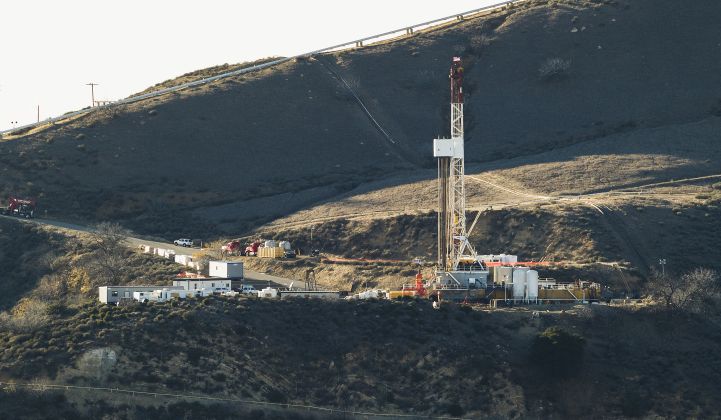The slow-rolling environmental disaster at the Aliso Canyon natural-gas storage facility is also a quick-approaching energy emergency for Southern California. Shutting down the reservoir of fuel for gas-fired power plants puts the region at risk of forced power outages. In response, state agencies and utilities have pledged to rush energy efficiency and demand response into action -- and now, they’re adding energy storage to the mix.
Last week, the California Public Utilities Commission (CPUC) officially ordered utility Southern California Edison to undertake an “expedited procurement” of large-scale, grid-connected energy storage resources to deal with the “distinct possibility of electricity service interruptions in the coming summer and winter months” caused by the Aliso Canyon shutdown.
The CPUC’s decision doesn’t specify how much energy storage SCE needs to procure. But Southern California Edison’s requests for offers (RFOs) released Friday provide more details, including a minimum size of 500 kilowatts per project for its straight energy storage RFO, and a separate “Design, Build, and Transfer” RFO that asks for projects capable of delivering 4 hours of energy storage, in increments of 5, 10, 15 and 20 megawatts apiece.
That indicates projects of some size, in keeping with the CPUC’s decision to exclude behind-the-meter storage in this procurement, to concentrate on getting larger grid-connected systems on-line as fast as possible. SCE will hold its first bidders conference on Thursday, and the CPUC wants offers in by June 17 and selections made by July 29. It has set a mid-September goal for approving the utility’s picks, as well as a Dec. 31 deadline for getting the projects themselves up and running.
Compared to the more typical year or more to turn storage RFOs into running projects, that turnaround “should be a record of sorts if achieved,” said Ravi Manghani, GTM Research’s chief energy storage analyst. “In spite of this short turnaround, CPUC is confident that it will receive several megawatts' worth of bids.”
“In the discussion, the commissioners implicitly acknowledged that it's likely that projects could get delayed by a month or two,” he said. “But ultimately the goal to impact winter 2016-17 demand is an equally important objective, and not just summer 2017.”
To meet that goal, the CPUC has invoked Gov. Jerry Brown’s Aliso Canyon emergency declaration in January to fast-track the process at multiple stages. It’s allowing SCE to fund the projects through the same cost allocation mechanism that accounts for its state-mandated storage projects, for example, though it notes that projects “should be price-competitive with previous solicitations” and be able to meet the same requirements.
The CPUC also approved SCE’s idea of utility-owned “build and transfer” projects, like the ones it’s deployed at some of its Orange County distribution substations, because it would increase the likelihood of resources being deployed in a timely manner. That could also allow the utility to pick and choose substations that could use the batteries to reduce their peak load, extend the life of grid equipment and potentially defer expensive grid upgrades.
The CPUC has also asked SCE to speed the interconnection of utility and third-party-owned systems -- something it should be fairly well equipped to do, given its experience in grid-scale battery projects and its software to analyze grid capacity for distributed energy resources down to the circuit level.
Under a pan-agency action plan formed to deal with the gas leak, state grid operator CAISO has also said that it can speed up its interconnection process for these projects, instead of putting them through its annual “cluster” bidding process, Manghani noted.
SCE has also seeded the market for short-turnaround storage deployment, so to speak, through a June RFP seeking “pre-engineered” combinations of batteries, power converters and control systems, capable of communicating with utility control systems via standard protocols, to deploy within six to eight months.
Even so, “this procurement could cause tightness in the supply chain due to the expedited nature,” Manghani said. “This indicates that bidders might bid aggressively on this RFO” -- a factor the CPUC noted in allowing SCE to take account of the extra costs of expedited development requirements and current market prices for equipment when judging cost-effectiveness against other projects.
As for the total market potential for the battery vendors, storage project developers, or thermal energy storage projects seeking a part of the bid, Manghani estimates that SCE could end up seeking 100 megawatts to 150 megawatts. That’s a big boost to the 50 megawatts of front-of-meter storage projects that GTM Research had previously projected would be deployed in California this year, and a not-insignificant adder to the U.S. 2016 forecast of 281 megawatts.
That figure is based on the CPUC’s emphasis on significantly reducing the risk of power shortages, the rationale for excluding smaller-scale behind-the-meter projects, and the sheer scope of the shortage the region faces.
According to the California Energy Commission, the Aliso Canyon shortage could affect power plants providing nearly 10,000 megawatts for the Los Angeles basin, most of which are called in to provide electricity on hot days or during power outages (PDF). Under a combination of worst-case circumstances, Southern California could see up to 14 days of blackouts this summer if nothing is done.



